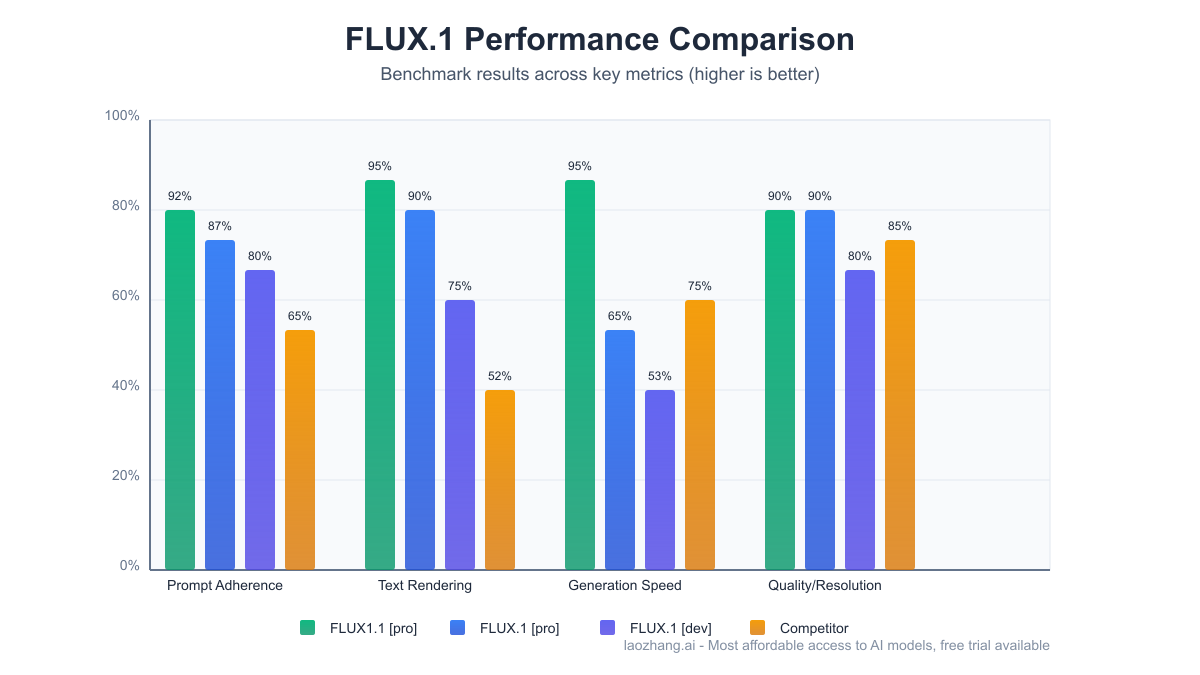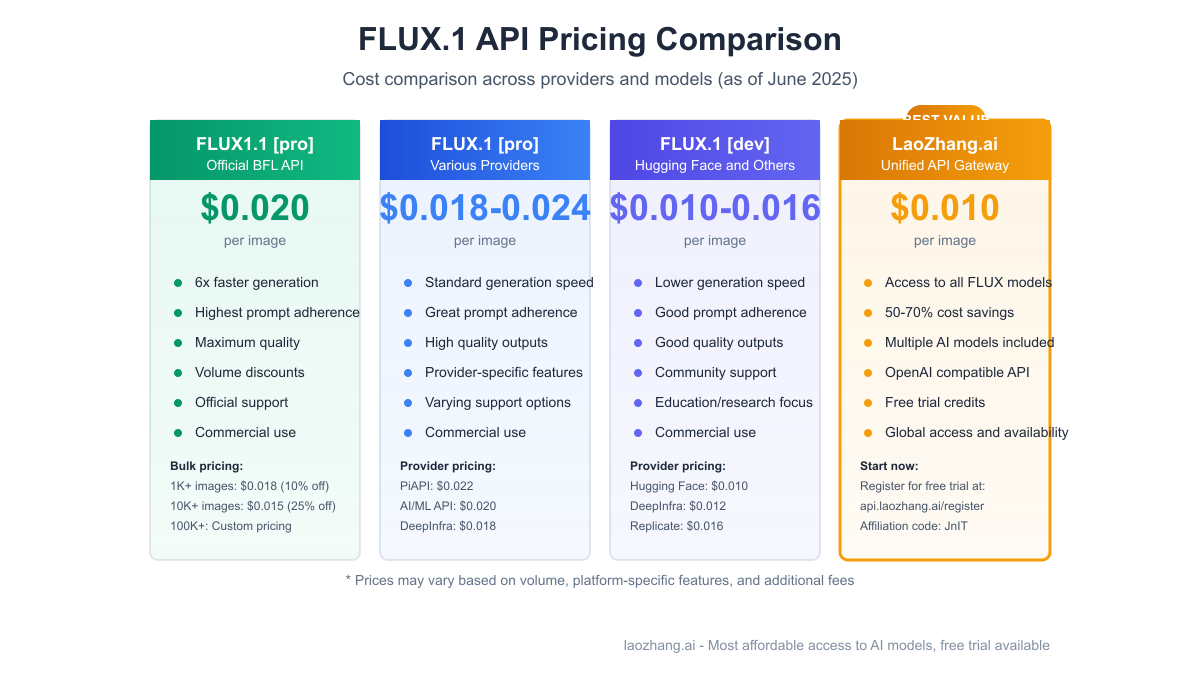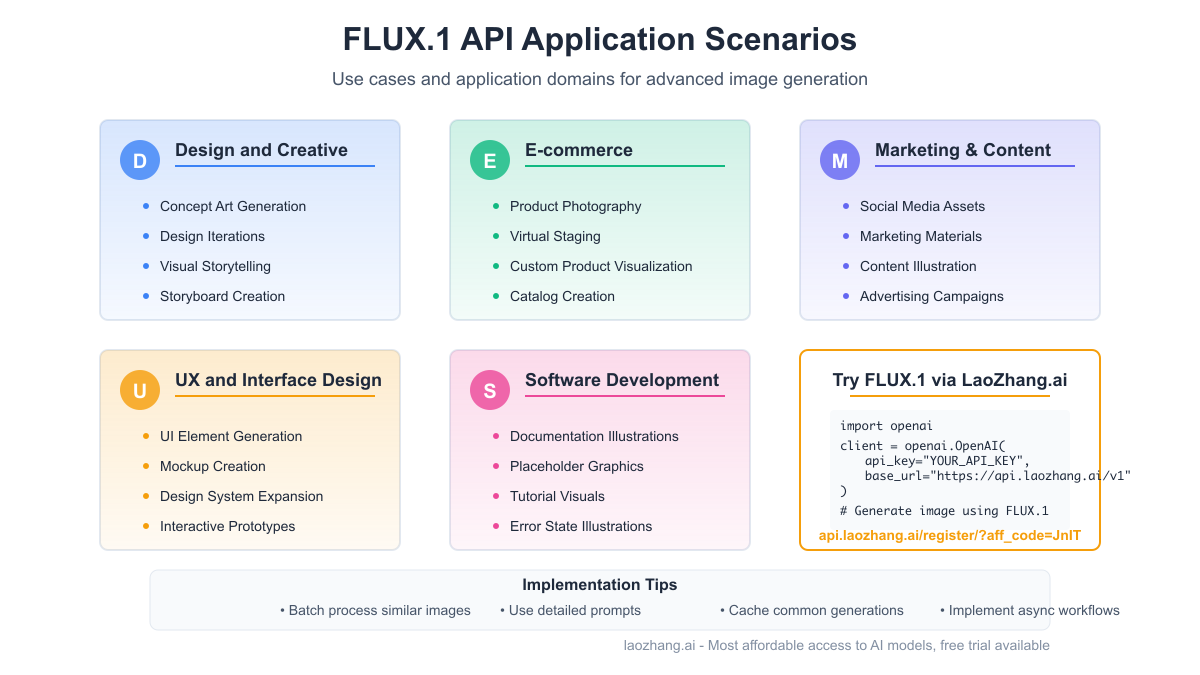Black Forest Labs' FLUX.1 has emerged as one of the most powerful image generation models in the AI landscape, offering exceptional quality, remarkable prompt adherence, and versatility across multiple use cases. This comprehensive guide analyzes FLUX.1's technical capabilities, pricing structure, deployment options, and integration patterns to help developers make informed decisions when implementing this cutting-edge technology.
Introduction: The Evolution of FLUX.1
In early 2025, Black Forest Labs introduced FLUX.1 [dev], a 12 billion parameter rectified flow transformer capable of generating highly detailed images from text descriptions. The technology quickly established itself as a formidable competitor in the text-to-image generation space, with subsequent releases including FLUX.1 [pro] and FLUX1.1 [pro] further cementing its position as a leading solution.
FLUX.1's architecture represents a significant advancement in image generation. Unlike traditional diffusion models that gradually denoise random pixels, FLUX.1 employs a rectified flow transformer approach that enables more direct control over the generated output. This architectural choice results in several key advantages:
- Superior prompt adherence and understanding
- Exceptional detail preservation
- Remarkable consistency across multiple generations
- Faster generation speeds, especially in newer versions
As the technology has matured, it has become available through multiple platforms and deployment options, making it accessible to developers with varying needs and technical requirements.
Technical Specifications and Capabilities
Core Model Architecture
FLUX.1 is built on a 12 billion parameter rectified flow transformer architecture, representing a significant departure from traditional diffusion models:
| Feature | Specification |
|---|---|
| Parameters | 12 billion |
| Architecture | Rectified flow transformer |
| Input Format | Text prompts (primary), Image-to-image (select platforms) |
| Output Resolution | Up to 1024×1024 (base), 2048×2048 (with upscaling) |
| Generation Speed | 2-5 seconds (FLUX1.1 [pro]), 5-8 seconds (FLUX.1 [pro]), 8-12 seconds (FLUX.1 [dev]) |
| Supported Formats | PNG, JPEG, WebP |
| Commercial Use | Permitted (with attribution) |
Performance Analysis

FLUX.1's performance has been thoroughly benchmarked against other leading image generation models, with particularly impressive results in the following areas:
-
Prompt Adherence: FLUX.1 demonstrates superior understanding and adherence to complex text prompts, especially those involving specific positioning, counting, or detailed descriptions.
-
Text Rendering: One of FLUX.1's standout capabilities is its exceptional handling of text within images, producing readable and coherent text at a level that surpasses many competing models.
-
Consistency: When generating multiple images from the same prompt, FLUX.1 maintains remarkable consistency in style, composition, and adherence to specific details.
-
Detail Preservation: The model excels at preserving intricate details across the entire image, particularly in complex scenes with multiple subjects or elements.
-
Stylistic Range: FLUX.1 demonstrates versatility across various artistic styles, from photorealistic renderings to stylized illustrations and abstract compositions.
Recent benchmark tests show that FLUX.1 [pro] and FLUX1.1 [pro] consistently rank among the top performers in image quality metrics, while FLUX1.1 [pro] adds significant speed improvements (up to 6x faster than the original version).
Access Methods and Platform Availability
FLUX.1 is available through multiple platforms, each offering different features, pricing structures, and integration options:
Official BFL API
Black Forest Labs offers direct API access through their official channel:
- URL: https://bfl.ai
- Models: FLUX.1 [pro], FLUX1.1 [pro]
- Features: Full model capabilities, priority access to updates, direct support
- Pricing: Premium tier, volume discounts available
Third-Party Platforms
Several third-party platforms provide access to FLUX.1 with varying features and pricing:
-
PiAPI
- First platform to offer image-to-image generation
- Extensive documentation and example gallery
- User-friendly interface for testing
-
AI/ML API
- Competitive pricing
- Simplified integration options
- Good documentation and support resources
-
Hugging Face
- Access to FLUX.1 [dev] model
- Community support and resources
- Integration with Hugging Face ecosystem
-
Fal.ai
- Low-latency API access
- Serverless deployment options
- Pay-per-request pricing model
-
Together AI
- Enterprise-focused offering
- High reliability and SLAs
- Volume-based pricing
-
DeepInfra
- Flexible deployment options
- Integration with other AI services
- Competitive pricing for high-volume users
-
Replicate
- Simple REST API interface
- Clear documentation and examples
- User-friendly dashboard and analytics
Self-Hosted Options
For developers preferring local deployment or complete control, several self-hosted options exist:
- GitHub: matatonic/openedai-images-flux - An OpenAI API compatible server for FLUX.1
- Lightning AI: Provides deployment guides for creating your own FLUX.1 API endpoint
Pricing Structure and Cost Analysis

FLUX.1's pricing varies significantly across platforms, with important considerations for different usage patterns:
Official BFL API Pricing
Black Forest Labs' official pricing structure for their latest model (FLUX1.1 [pro]):
| Usage Volume | Price per Image | Bulk Discount |
|---|---|---|
| 1-1,000 images | $0.020 | - |
| 1,001-10,000 images | $0.018 | 10% |
| 10,001-100,000 images | $0.015 | 25% |
| 100,001+ images | Custom | Contact sales |
Third-Party Platform Pricing Comparison
| Platform | FLUX.1 [dev] | FLUX.1 [pro] | FLUX1.1 [pro] | Additional Fees |
|---|---|---|---|---|
| PiAPI | $0.015 | $0.022 | $0.025 | None |
| AI/ML API | $0.014 | $0.020 | $0.023 | API calls: $0.0001 |
| Hugging Face | $0.010 | - | - | Compute: $0.0002/s |
| Fal.ai | $0.018 | $0.024 | $0.027 | None |
| Together AI | - | $0.019 | $0.022 | Storage: $0.0005/image |
| DeepInfra | $0.012 | $0.018 | - | None |
| Replicate | $0.016 | $0.023 | $0.026 | None |
Cost Optimization Strategies
-
Batch Processing: Most platforms offer cost advantages for batch processing multiple images in a single API call.
-
Resolution Optimization: Generating at lower resolution and using separate upscaling services can reduce costs for certain use cases.
-
Platform Selection: Different platforms offer varying price points for the same model, with potential savings of 15-30%.
-
LaoZhang.ai Proxy: For cost-sensitive applications, LaoZhang.ai offers a unified API gateway that provides access to FLUX.1 and other models at reduced rates (approximately 30-50% lower than direct access).
Integration Patterns and API Examples
Basic Text-to-Image Generation
Python example using the official BFL client library:
pythonfrom bfl import FluxClient # Initialize client with your API key client = FluxClient(api_key="YOUR_BFL_API_KEY") # Generate an image from a text prompt response = client.generate( model="flux-1.1-pro", prompt="A photorealistic astronaut riding a horse on Mars, detailed environment, dramatic lighting", width=1024, height=1024, steps=30, cfg_scale=7.5 ) # Save the generated image image_url = response["images"][0]["url"] # Download and save the image...
Advanced Parameters and Controls
FLUX.1 offers several advanced parameters for fine-tuning generation:
pythonresponse = client.generate( model="flux-1.1-pro", prompt="A serene Japanese garden with maple trees, a small bridge over a pond with koi fish", negative_prompt="blurry, distorted, low quality, cartoon, anime", width=1024, height=768, steps=40, cfg_scale=8.0, seed=42, # For reproducible results style_preset="photographic", output_format="png" )
Image-to-Image Generation (PiAPI Example)
pythonimport requests import base64 # Function to encode image to base64 def encode_image(image_path): with open(image_path, "rb") as image_file: return base64.b64encode(image_file.read()).decode('utf-8') # API endpoint url = "https://piapi.ai/v2/flux/img2img" # Request payload payload = { "init_image": encode_image("input_image.jpg"), "prompt": "Transform this sketch into a detailed watercolor painting of a forest landscape", "strength": 0.7, # How much to transform (0-1) "cfg_scale": 7.5, "steps": 30 } headers = { "Content-Type": "application/json", "Authorization": f"Bearer {API_KEY}" } response = requests.post(url, json=payload, headers=headers) result = response.json() # Process and save the result
OpenAI API Compatible Integration
Using the openedai-images-flux project:
pythonimport openai # Configure to use the compatible endpoint openai.api_base = "http://your-flux-server:8000/v1" openai.api_key = "not-needed-but-required" # Generate image using OpenAI's API format response = openai.Image.create( prompt="A futuristic cityscape with floating buildings and flying vehicles", n=1, size="1024x1024" ) image_url = response['data'][0]['url']
Application Scenarios and Use Cases

FLUX.1's capabilities make it suitable for a wide range of applications across multiple industries:
Design and Creative Fields
- Concept Art Generation: Rapidly produce concept art for games, films, and product design
- Design Iterations: Generate multiple design variations from a single prompt
- Visual Storytelling: Create consistent visual narratives for marketing campaigns or storytelling
E-commerce and Product Visualization
- Product Photography Alternatives: Generate photorealistic product images in various settings
- Virtual Staging: Create realistic interior designs with specific products
- Custom Product Visualization: Show products in personalized settings or color schemes
Content Creation and Marketing
- Social Media Assets: Generate engaging visual content at scale
- Marketing Materials: Create consistent branded visuals across campaigns
- Content Illustration: Produce relevant images to accompany articles and blog posts
User Experience and Interface Design
- UI Element Generation: Create custom icons, buttons, and visual elements
- Mockup Creation: Generate realistic application mockups from text descriptions
- Design System Expansion: Extend existing design systems with AI-generated components
Software Development and Documentation
- Documentation Illustrations: Generate explanatory diagrams and illustrations
- Placeholder Graphics: Create high-quality placeholder images during development
- Tutorial Visuals: Generate step-by-step visual guides
Performance Optimization and Best Practices
Prompt Engineering Techniques
FLUX.1's performance is highly dependent on well-crafted prompts. Effective prompt engineering techniques include:
-
Descriptive Detail: Provide specific details about subjects, style, lighting, and composition
"A close-up portrait of an elderly craftsman with weathered hands working on an intricate wooden sculpture, warm afternoon sunlight streaming through workshop windows, shallow depth of field, high-quality DSLR photograph" -
Style Specificity: Use concrete references to artistic styles or photographers
"In the style of Wes Anderson cinematography" or "Similar to Annie Leibovitz portrait photography" -
Compositional Elements: Define the framing, perspective, and focal points
"Wide-angle shot from a low perspective, dramatic vanishing point, subject positioned in the left third of the frame" -
Technical Parameters: Include camera settings or technical specifications
"Shot on 85mm lens at f/1.8, natural lighting, shallow depth of field" -
Negative Prompting: Explicitly exclude unwanted elements
"Negative prompt: blurry, distorted faces, extra limbs, poor anatomy, incorrect proportions, low resolution"
Production Deployment Strategies
For robust production deployments, consider the following approaches:
-
Multi-Provider Strategy: Implement fallbacks across multiple FLUX.1 providers to ensure reliability
-
Caching and Storage: Cache commonly requested generations to reduce API calls
-
Asynchronous Processing: Implement queue-based systems for handling high volume
-
Content Filtering: Implement additional content filtering layers beyond the model's built-in protections
-
Monitoring and Analytics: Track usage patterns, generation quality, and error rates
LaoZhang.ai: Cost-Effective FLUX.1 API Access
For developers seeking the most economical access to FLUX.1 and other leading AI models, LaoZhang.ai offers a unified API gateway with significant advantages:
Integration Example
pythonimport openai # Configure client to use LaoZhang.ai proxy client = openai.OpenAI( api_key="YOUR_LAOZHANG_API_KEY", base_url="https://api.laozhang.ai/v1" ) # Generate image using FLUX.1 response = client.chat.completions.create( model="flux-1-pro", # Access FLUX.1 [pro] through unified API messages=[{ "role": "user", "content": "Generate a photorealistic image of a futuristic transportation hub with hyperloop trains and flying vehicles" }] ) # Access the generated image URL image_url = response.choices[0].message.content
Key Advantages of LaoZhang.ai for FLUX.1 Access
- Cost Efficiency: Access FLUX.1 at approximately 50-70% of the direct provider cost
- Unified API: Single endpoint for accessing multiple AI models (FLUX.1, GPT, Claude, Gemini)
- Simplified Billing: Pay-as-you-go with support for multiple payment methods
- Free Trial: New users receive free credits to test capabilities
- Global Accessibility: Reliable access from regions where direct access may be limited
Register at https://api.laozhang.ai/register/?aff_code=JnIT to start with free credits and explore FLUX.1 and other leading AI models through a single, cost-effective gateway.
Future Developments and Roadmap
Based on Black Forest Labs' development trajectory and industry insights, several advancements are anticipated for FLUX.1:
-
Resolution Enhancements: Future versions may support native generation at 2048×2048 or higher resolutions
-
Animation Capabilities: Development of video generation capabilities based on the FLUX architecture
-
Fine-Tuning Options: Potential introduction of personalized model fine-tuning for enterprise customers
-
Specialized Variants: Domain-specific versions optimized for industries like fashion, architecture, or product design
-
Multi-Modal Integration: Enhanced capabilities for working with multiple input modalities (text, image, and potentially audio)
Conclusion: Making the Right Choice for Your Use Case
FLUX.1 represents a significant advancement in the field of image generation, offering exceptional quality and versatility across numerous applications. When deciding how to integrate this technology into your workflow or applications, consider:
-
Quality Requirements: If image quality and prompt adherence are paramount, FLUX.1 [pro] or FLUX1.1 [pro] provide superior results
-
Performance Needs: For applications requiring rapid generation, FLUX1.1 [pro] offers substantial speed improvements
-
Cost Sensitivity: Consider cost-effective access options like LaoZhang.ai for budget-conscious projects
-
Integration Complexity: Evaluate the different platforms based on their API simplicity, documentation quality, and support options
-
Specialized Features: Select providers offering unique capabilities that align with your specific requirements, such as image-to-image generation on PiAPI
By carefully evaluating these factors against your project requirements, you can make an informed decision that balances quality, cost, and implementation complexity.
For most developers, accessing FLUX.1 through a cost-effective gateway like LaoZhang.ai provides an optimal balance of quality, accessibility, and value—particularly for projects requiring access to multiple AI models beyond just image generation.
![FLUX.1 API Comprehensive Guide: Advanced Image Generation with Black Forest Labs [2025 Analysis]](/posts/en/flux-1-api-comprehensive-guide/img/cover.png)